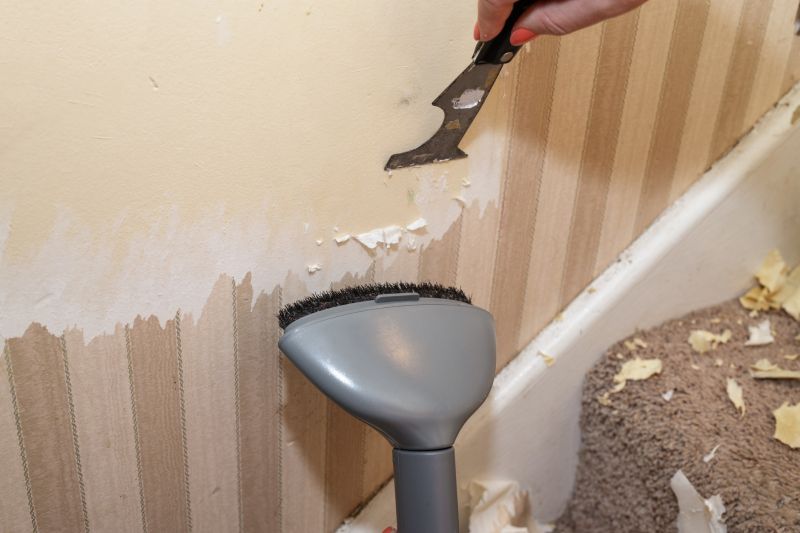Top Products For Wallpaper Removals To Make Your Job Easier
Explore the most effective tools and supplies designed to simplify wallpaper removal and deliver professional results.
 Removing wallpaper can be a challenging task that requires the right tools and products to achieve a clean and smooth wall surface. Whether dealing with stubborn adhesives or delicate wallpaper, selecting appropriate removal products can make the process more efficient and less damaging to the underlying drywall or paint. Commonly used items include specialized solutions that loosen adhesive bonds, scrapers designed to minimize wall damage, and steamers that soften wallpaper for easier removal. Understanding the different types of products available can help homeowners and DIY enthusiasts choose the best options for their specific project needs.
Removing wallpaper can be a challenging task that requires the right tools and products to achieve a clean and smooth wall surface. Whether dealing with stubborn adhesives or delicate wallpaper, selecting appropriate removal products can make the process more efficient and less damaging to the underlying drywall or paint. Commonly used items include specialized solutions that loosen adhesive bonds, scrapers designed to minimize wall damage, and steamers that soften wallpaper for easier removal. Understanding the different types of products available can help homeowners and DIY enthusiasts choose the best options for their specific project needs.
Top Overall Option
Multi-Purpose Wallpaper Removal Kit
A comprehensive kit that includes a variety of tools and solutions designed for different wallpaper removal challenges. It features a chemical remover, a steam applicator, and durable scrapers, making it suitable for various wall types and wallpaper conditions. This all-in-one set provides versatility and convenience for DIYers seeking a complete solution for wallpaper removal projects.
Types of Products For Wallpaper Removals
Chemical Wallpaper Removers
Liquid solutions formulated to dissolve adhesive residues, facilitating easier peeling of wallpaper.
Steam Wallpaper Steamer
Devices that produce steam to soften wallpaper, making removal less labor-intensive without chemical use.
Scrapers and Putty Knives
Tools designed to gently lift and peel wallpaper after adhesive has been loosened or softened.
Spray Bottles
Used to apply water or removal solutions evenly across wallpaper surfaces.
Adhesive Removers
Specialized products to eliminate residual glue after wallpaper has been removed.
Heat Guns
Portable devices that emit hot air to help loosen wallpaper adhesives.
Plastic Putty Knives
Non-abrasive tools that minimize wall damage during removal.
Wallpaper Scoring Tools
Tools that create small perforations in wallpaper to allow removal solutions to penetrate more effectively.
Infrared Wallpaper Removers
Advanced devices that use infrared heat to soften wallpaper for easier removal.
Electric Wallpaper Strippers
Powered tools designed to automate the softening process, reducing manual effort.
Popular Choices
Widely used liquid removers effective for various wallpaper types and adhesive strengths.
Compact steam devices favored for their ease of use and versatility in small to medium projects.
Durable tools suitable for removing thick or textured wallpaper with minimal wall damage.
Complete sets that combine chemical solutions, tools, and accessories for comprehensive removal tasks.
Products designed to clean and prepare walls after wallpaper removal for repainting or re-wallpapering.
Popular for their ability to soften adhesives quickly with adjustable heat settings.
Tools that create small holes to improve solution penetration, widely used in professional settings.
Emerging favorites due to their effective heat application and ease of use.
Automated tools appreciated for reducing manual effort during large projects.
Common accessories used across various removal methods for even application of solutions.
Effective wallpaper removal often involves a combination of chemical solutions and physical tools. Chemical removers are formulated to break down adhesives, making it easier to peel or scrape off wallpaper. These products vary in strength and application method, so reading instructions carefully is essential. Physical tools like putty knives, scrapers, and squeegees help lift and peel wallpaper once the adhesive has been loosened. For large or stubborn wallpaper, steamers provide a non-chemical method to soften the material, enabling easier removal without harsh chemicals.
Proper preparation before starting removal can significantly impact the ease and success of the project. It is advisable to test a small area first, especially when using chemical solutions, to ensure there is no damage to the wall surface. Wearing protective gear such as gloves and masks is recommended when working with chemical removers. After removal, cleaning the wall thoroughly to eliminate residual adhesive and preparing the surface for repainting or re-wallpapering are important steps to ensure a professional-looking finish.
Key Buying Considerations
- Wall surface compatibility: Ensure the product is safe for your specific wall type, such as drywall or plaster.
- Wallpaper type: Different products work better with vinyl, fabric, or paper wallpapers.
- Adhesive strength: Consider whether the wallpaper has a light or heavy adhesive to select appropriate removal methods.
- Ease of use: Look for tools and solutions that match your skill level and project size.
- Chemical sensitivities: Be mindful of any sensitivities to chemicals; opt for less harsh options if needed.
- Safety features: Choose products with clear instructions and safety warnings, especially for chemical removers and heat tools.
- Environmental conditions: Adequate ventilation is important when using chemical solutions or heat-based tools.
- Project scale: Larger projects may benefit from powered tools or comprehensive kits.
- Wall preparation: Consider whether the product requires pre-treatment or specific surface preparation.
- Post-removal surface: Ensure the product leaves the wall surface ready for repainting or re-wallpapering without additional cleaning.
- Durability and quality: Invest in well-made tools to ensure they withstand multiple uses without damage.
- Cost and value: Balance the price with the range of features and effectiveness offered.
- Availability of replacements or accessories: Check if additional blades, solutions, or parts are easy to obtain.
- Environmental impact: Consider the disposal and environmental safety of chemical products used.
This content contains affiliate links. We may earn a commission if you purchase through these links, at no additional cost to you.
